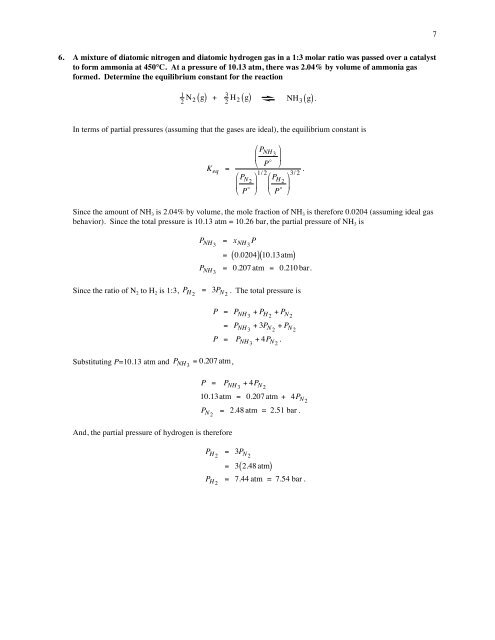Problem Set 8 Solutions
Problem Set 8 Solutions
Problem Set 8 Solutions
Create successful ePaper yourself
Turn your PDF publications into a flip-book with our unique Google optimized e-Paper software.
76. A mixture of diatomic nitrogen and diatomic hydrogen gas in a 1:3 molar ratio was passed over a catalystto form ammonia at 450°C. At a pressure of 10.13 atm, there was 2.04% by volume of ammonia gasformed. Determine the equilibrium constant for the reaction12 N 2 ( g ) +32 H 2 ( g )NH 3 ( g).In terms of partial pressures (assuming that the gases are ideal), the equilibrium constant is€€K eq ="$#P N 2P !" P NH %$ 3# P ! '&%1/ 2 3/ 2" PH %.' $ 2& # P ! '&Since the amount of NH 3 is 2.04% by volume, the mole fraction of NH 3 is therefore 0.0204 (assuming ideal gasbehavior). Since the total pressure is 10.13 atm = 10.26 bar, the partial pressure of NH€3 isP NH 3P NH 3= x NH 3P( )( 10.13atm)= 0.0204= 0.207 atm = 0.210 bar.Since the ratio of N 2 to H 2 is 1:3,€€P H 2= 3P N 2. The total pressure isP = P NH 3+ P H 2+ P N 2= P NH 3+ 3P N 2+ P N 2P = P NH 3+ 4P N 2.Substituting P=10.13 atm and€P NH 3= 0.207 atm,€P = P NH 3+ 4P N 210.13atm = 0.207 atm + 4P N 2P N 2= 2.48 atm = 2.51 bar .And, the partial pressure of hydrogen is therefore€P H 2= 3P N 2= 3 2.48 atm ( )P H 2= 7.44 atm = 7.54 bar .€
















